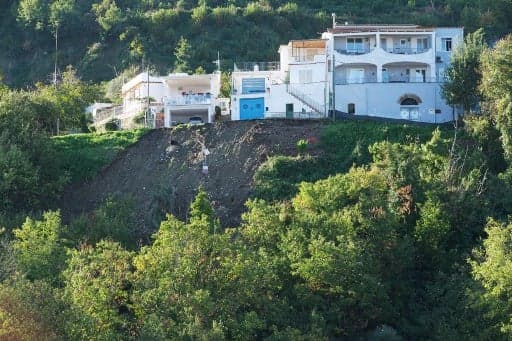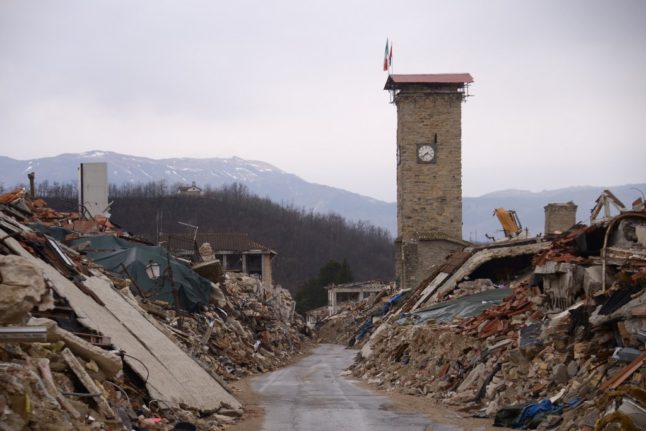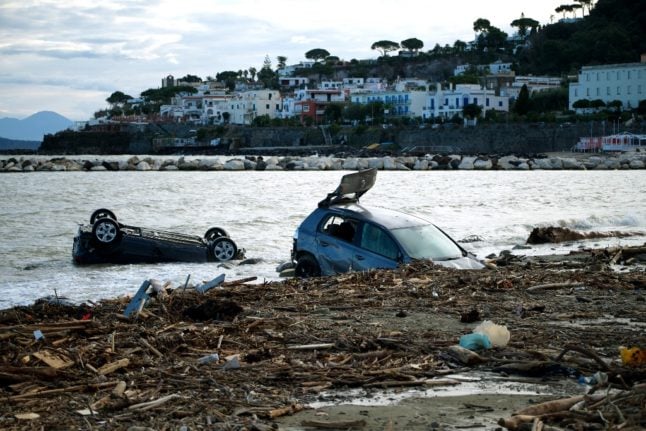Landslides and earthquakes: Why Ischia - and most of Italy - is at risk

The deadly landslide that struck the island of Ischia was not a one-off and Italy faces widespread problems that leave much of the country at high risk from natural disasters, says Silvia Marchetti.
The terrible landslide that rocked Ischia this week is unfortunately no news. In 2017 the island was struck by an earthquake and now we’re back to square one, with the same problems still unsolved.
It’s a country-wide issue. It's scary to believe, yet 94 percent of Italian towns are at risk of natural disasters, ranging from floods and landslides to mudslides and coastal erosion, according to the environmental protection agency ISPRA.
Meanwhile, data from Italy’s Department for Civil Protection suggests that over 45 percent are located in seismic areas at the mercy of potential quakes.
Italy is a very old country, nearly all of its towns and villages date back centuries when no safe-building regulations had even been thought of.
It might not occur to visitors that many stunning hilltop villages with their appealing historic centers full of crumbling houses and emblazoned stone columns share a dark past: many were hit by natural calamities which sent locals running for their lives, abandoning their homes.
READ ALSO: Row over illegal construction in Italy after deadly Ischia landslide
I remember once touring Umbria and stopping at this tiny hamlet near Foligno where only four people live. It was struck by an earthquake in the 1960s and everything froze: in the rush of getting out of their houses families left everything behind, pots and pans still dangle in the kitchens, and torn embroidered cotton curtains hang on unhinged window frames.
When the terrible earthquake hit Amatrice and surroundings in 2016 friends of mine who had bought a rural farm near Todi in 2013, even though they only felt it slightly, got so scared they seriously considered selling it and returning to Turin.

Collapsed buildings in the historic center of Amatrice eight months after a 6.0 quake completely destroyed the town on August 24, 2016, killing nearly 300 people. (Photo by Filippo MONTEFORTE / AFP)
Depopulation plagues Italy’s villages: alongside migration the other cause is the risk of natural disasters.
Many old villages in recent years have put abandoned houses up for sale at bargain prices, even for just one euro, in the hope of breathing new life into their ancient districts. Foreigners rushing to snatch up such a property are often oblivious to the fact that the area is a high-risk one for natural disasters, and that the quake or flood that drove out inhabitants years before could strike again. That said, I have met conscious foreign buyers who sent in experts to ascertain whether the structure was solid before grabbing a bargain.
After Irpinia in the Campania region was rocked by a terrible quake in 1980 several villages there, like Zungoli and Bisaccia, have tried to sell off hundreds of old homes.
Abruzzo, particularly the area close to L’Aquila which was most recently hit by an earthquake in 2006, features spellbinding villages such as Rocca Calascio and Santo Stefano where local authorities have paid people to move there.
Even though Santo Stefano’s ancient neighborhood has been partly renovated with seismic architecture it still lies in one of Italy’s most dangerous areas.

Rocca Calascio's ghost fortress in Abruzzo’s Parco del Gran Sasso. Photo by Silvia Marchetti/The Local
Most old villages have never been given a thorough makeover, with many decaying buildings, while new dwellings are poorly constructed and lack safety regulations.
The truth is, the whole of Italy needs a reconstruction plan to prepare for natural disasters - but despite territorial mappings of risk zones very little has been done.
After nearly 14 years, L’Aquila’s historical center is still ‘un cantiere aperto’ (an open-air building site).
The issue of abusivismo (construction without permits) is a major problem in Italy which increases geological hazards.
Old homes may collapse because of time, weather and natural calamities but they were built in an era when risk-prevention was unknown, while new buildings and neighborhoods often spring up in high-risk, red zone areas known to have been struck in the past by a flood or quake.
It’s not because residents and local authorities don’t know about the dangers. They simply don’t care and disregard the risks. The country has been mapped to classify levels of seismic risk but it seems these are seldom taken into account.
That’s what happened in Ischia: the houses that were wiped away by the landslide should never have been built in the first place. That area at the feet of Mount Epomeo (an active volcano) needed to be clear to allow rainwater to drain down to the sea.
MAP: Which parts of Italy have the highest risk of earthquakes?
They were illegal (abusive) homes, built without permits but later ‘legalized’ through state amnesties if penalty taxes were paid.
It is known that Ischia’s landslide and earthquake were linked to the underground activity of the volcano (there are fumaroles and hot baths), but given that in the last 5,500 years there have been only 45 eruptions, the last one in 1302, it seems like a faraway threat.

Damaged cars on the beach of Casamicciola on November 27, 2022, following a landslide on the island of Ischia, southern Italy. Photo by Eliano IMPERATO / AFP
Even though state funds are regularly allocated to reduce geological hazards by upgrading buildings, such as the recent sismabonus for quake-proof fixes, the money isn’t always used appropriately.
Also, local bodies struggle to keep track of where such investments end up due to labyrinthine bureaucracy and ‘infiltrazione’ (infiltration) of criminal gangs in the building business. These win public tenders by bidding low and then build cheap homes with poor materials that collapse when a natural disaster strikes.
I don’t think this vicious circle will ever stop. It’s not just about upgrading the architecture of historical centers and old homes, or building seismic-proof new ones.
Enforcing tougher penalties against abusivismo has led nowhere. You need to change the mindset of Italian people eager to throw up a seaside home no matter the risk, and put an end to detrimental amnesties in high-risk zones.
Comments
See Also
The terrible landslide that rocked Ischia this week is unfortunately no news. In 2017 the island was struck by an earthquake and now we’re back to square one, with the same problems still unsolved.
It’s a country-wide issue. It's scary to believe, yet 94 percent of Italian towns are at risk of natural disasters, ranging from floods and landslides to mudslides and coastal erosion, according to the environmental protection agency ISPRA.
Meanwhile, data from Italy’s Department for Civil Protection suggests that over 45 percent are located in seismic areas at the mercy of potential quakes.
Italy is a very old country, nearly all of its towns and villages date back centuries when no safe-building regulations had even been thought of.
It might not occur to visitors that many stunning hilltop villages with their appealing historic centers full of crumbling houses and emblazoned stone columns share a dark past: many were hit by natural calamities which sent locals running for their lives, abandoning their homes.
READ ALSO: Row over illegal construction in Italy after deadly Ischia landslide
I remember once touring Umbria and stopping at this tiny hamlet near Foligno where only four people live. It was struck by an earthquake in the 1960s and everything froze: in the rush of getting out of their houses families left everything behind, pots and pans still dangle in the kitchens, and torn embroidered cotton curtains hang on unhinged window frames.
When the terrible earthquake hit Amatrice and surroundings in 2016 friends of mine who had bought a rural farm near Todi in 2013, even though they only felt it slightly, got so scared they seriously considered selling it and returning to Turin.

Depopulation plagues Italy’s villages: alongside migration the other cause is the risk of natural disasters.
Many old villages in recent years have put abandoned houses up for sale at bargain prices, even for just one euro, in the hope of breathing new life into their ancient districts. Foreigners rushing to snatch up such a property are often oblivious to the fact that the area is a high-risk one for natural disasters, and that the quake or flood that drove out inhabitants years before could strike again. That said, I have met conscious foreign buyers who sent in experts to ascertain whether the structure was solid before grabbing a bargain.
After Irpinia in the Campania region was rocked by a terrible quake in 1980 several villages there, like Zungoli and Bisaccia, have tried to sell off hundreds of old homes.
Abruzzo, particularly the area close to L’Aquila which was most recently hit by an earthquake in 2006, features spellbinding villages such as Rocca Calascio and Santo Stefano where local authorities have paid people to move there.
Even though Santo Stefano’s ancient neighborhood has been partly renovated with seismic architecture it still lies in one of Italy’s most dangerous areas.

Most old villages have never been given a thorough makeover, with many decaying buildings, while new dwellings are poorly constructed and lack safety regulations.
The truth is, the whole of Italy needs a reconstruction plan to prepare for natural disasters - but despite territorial mappings of risk zones very little has been done.
After nearly 14 years, L’Aquila’s historical center is still ‘un cantiere aperto’ (an open-air building site).
The issue of abusivismo (construction without permits) is a major problem in Italy which increases geological hazards.
Old homes may collapse because of time, weather and natural calamities but they were built in an era when risk-prevention was unknown, while new buildings and neighborhoods often spring up in high-risk, red zone areas known to have been struck in the past by a flood or quake.
It’s not because residents and local authorities don’t know about the dangers. They simply don’t care and disregard the risks. The country has been mapped to classify levels of seismic risk but it seems these are seldom taken into account.
That’s what happened in Ischia: the houses that were wiped away by the landslide should never have been built in the first place. That area at the feet of Mount Epomeo (an active volcano) needed to be clear to allow rainwater to drain down to the sea.
MAP: Which parts of Italy have the highest risk of earthquakes?
They were illegal (abusive) homes, built without permits but later ‘legalized’ through state amnesties if penalty taxes were paid.
It is known that Ischia’s landslide and earthquake were linked to the underground activity of the volcano (there are fumaroles and hot baths), but given that in the last 5,500 years there have been only 45 eruptions, the last one in 1302, it seems like a faraway threat.

Even though state funds are regularly allocated to reduce geological hazards by upgrading buildings, such as the recent sismabonus for quake-proof fixes, the money isn’t always used appropriately.
Also, local bodies struggle to keep track of where such investments end up due to labyrinthine bureaucracy and ‘infiltrazione’ (infiltration) of criminal gangs in the building business. These win public tenders by bidding low and then build cheap homes with poor materials that collapse when a natural disaster strikes.
I don’t think this vicious circle will ever stop. It’s not just about upgrading the architecture of historical centers and old homes, or building seismic-proof new ones.
Enforcing tougher penalties against abusivismo has led nowhere. You need to change the mindset of Italian people eager to throw up a seaside home no matter the risk, and put an end to detrimental amnesties in high-risk zones.
Join the conversation in our comments section below. Share your own views and experience and if you have a question or suggestion for our journalists then email us at [email protected].
Please keep comments civil, constructive and on topic – and make sure to read our terms of use before getting involved.
Please log in here to leave a comment.